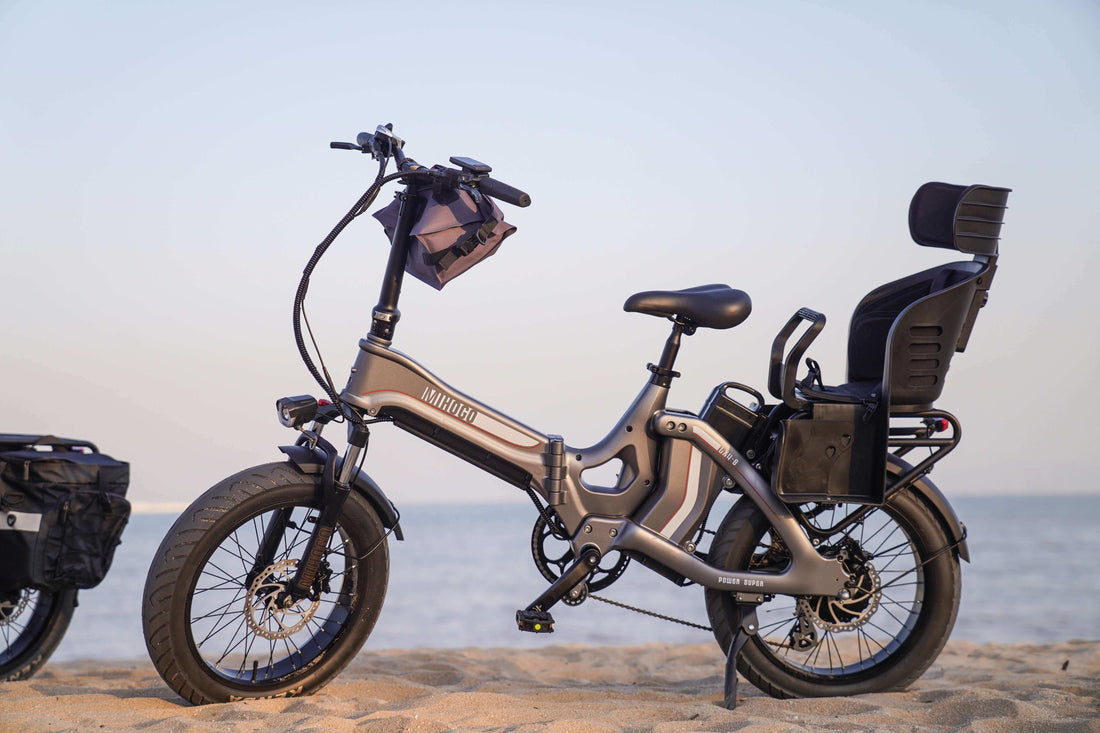EU Standard E-Bike Classifications
European e-bikes fall into distinct categories that determine where and how fast you can ride:
Pedelecs (Standard E-Bikes)
- Maximum motor power: 250 watts
- Speed assistance: Up to 25 km/h
- No insurance or road tax required
- Pedal-assist only operation
- Mihogo Models: All Mihogo e-bikes (ONE Utility, Air Max, Mini, RX 2.4) comply with these EU standards
Speed Pedelecs (S-Pedelecs)
- Maximum speed: 45 km/h
- Continuous rated power must not exceed 4 times human power (approximately 1000W)
- Require registration, insurance, and helmets
- Considered mopeds under EU law
Speed Limits for Different Riding Areas
Bike Lanes and Cycle Paths
Standard e-bikes are allowed on bike lanes and designated paths throughout Europe. The universal 25 km/h speed limit applies, but local authorities may impose lower limits in specific areas.
Key Guidelines:
- Always respect posted speed limits
- Yield to pedestrians in shared spaces
- Use bike lanes when available
- Best Electric Bike Accessories for Safe Riding
Pedestrian Zones and Shared Spaces
Standard e-bikes are allowed on bike lanes and some pedestrian zones, but regulations vary significantly by country:
Germany: Minimum and maximum speeds for riding are 6 and 20km/h respectively in pedestrian areas Italy: Street-legal ebike speeds limited to 6km/h on pedestrian routes Spain: E-bikes permitted in some pedestrian zones with reduced speed limits
Urban Roads and Traffic Areas
Standard e-bikes can use regular roads alongside traffic, maintaining the 25 km/h assistance limit. Above this speed, the motor must disengage, meaning the bike becomes purely mechanical.
Country-Specific Speed Regulations
Germany - Strict Compliance Standards
Germany legalized e-bikes on roads in 2019 with comprehensive regulations:
- Maximum bike weight: 55kg
- Minimum age: 15 years for pedelecs
- Mandatory equipment: Strong handlebars, proper lighting
- Speed pedelecs require helmets and registration
France - Urban Integration Focus
French cities encourage eco-friendly transportation with favorable e-bike policies:
- Standard e-bikes allowed on all public roads and bike lanes
- Specific velocity limitations in pedestrian areas
- European Cycling Federation Guidelines
Netherlands - Cycling Infrastructure Leader
E-bike riders should be at least 16 years old in the Netherlands:
- Extensive bike lane network
- Standard e-bikes treated as regular bicycles
- Speed pedelecs permitted on bike paths with restrictions
Technical Compliance for Mihogo E-Bikes
All Mihogo electric bikes are designed to meet EU standards:
Mihogo ONE Utility E-Bike
- 250W compliant motor
- 25 km/h speed assistance cutoff
- Ideal for urban commuting and cargo transport
- Perfect for bike lanes and shared paths
Mihogo Air Max
- Lightweight design for easy maneuverability
- EU-compliant speed limits
- Suitable for mixed urban and recreational riding
Mihogo Mini & RX 2.4
- Compact designs meeting all European regulations
- Safe for all designated e-bike areas
- Folding Electric Bikes for City Riding
Safety Considerations and Best Practices
Helmet Requirements by Country
Helmet use is compulsory for speed pedelec users and all standard e-bikers using interurban roads in Spain, while requirements vary elsewhere:
- Mandatory: Speed pedelecs in all EU countries
- Recommended: Standard e-bikes (varies by country)
- Age-specific: Some countries require helmets for riders under 18
Lighting and Visibility
Spanish electric bicycle law requires users turn on lights at night and during poor visibility conditions. Similar requirements exist across Europe:
- Front white light and rear red light
- Reflectors on wheels and pedals
- High-visibility clothing recommended
2025 Trends and Future Regulations
The European eBike market is projected to reach €15.6 billion in 2025, driving regulatory updates:
Emerging Trends:
- AI algorithms that adjust motor output based on terrain, rider weight, and riding style
- Enhanced safety features in urban environments
- Integration with smart city infrastructure
Regulatory Evolution:
- Stricter battery safety standards
- Improved anti-theft systems
- Enhanced pedestrian protection measures
Wikipedia: Electric Bicycle Regulations
Legal Compliance Checklist for Mihogo Riders
✅ Motor Power: 250W maximum (all Mihogo models compliant)
✅ Speed Limit: 25 km/h assistance cutoff
✅ Documentation: EU declaration of conformity including CE marking required
✅ Age Requirements: Check local minimums (typically 14-16 years)
✅ Equipment: Proper lighting, bells, reflectors
✅ Insurance: Not required for standard e-bikes
Frequently Asked Questions
Q: Can I ride my Mihogo e-bike faster than 25 km/h? A: You can exceed 25 km/h through pedaling alone, but motor assistance cuts off at this speed.
Q: Do I need a license for my Mihogo e-bike? A: No license required for standard pedelecs meeting EU 250W/25 km/h limits.
Q: Where can't I ride my e-bike? A: Speed pedelecs must not be used in prohibited bike lanes, and local restrictions may apply to specific pedestrian areas.
Conclusion
Understanding e-bike speed limits and legal riding areas ensures safe, compliant use of your Mihogo electric bike across Europe. With standardized EU regulations and growing infrastructure support, e-bikes offer an excellent sustainable transportation solution. Always check local regulations when traveling, respect speed limits in all areas, and prioritize safety through proper equipment and responsible riding.
By 2030, eBikes are expected to account for 50% of all bicycle sales in Europe, making now the perfect time to join the electric mobility revolution with a compliant, high-quality Mihogo e-bike.






